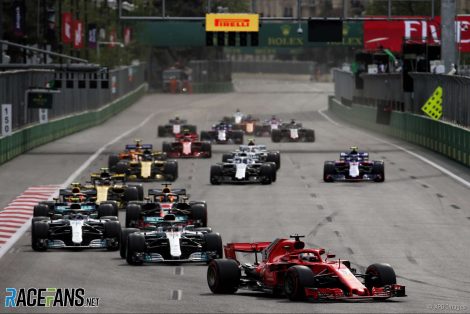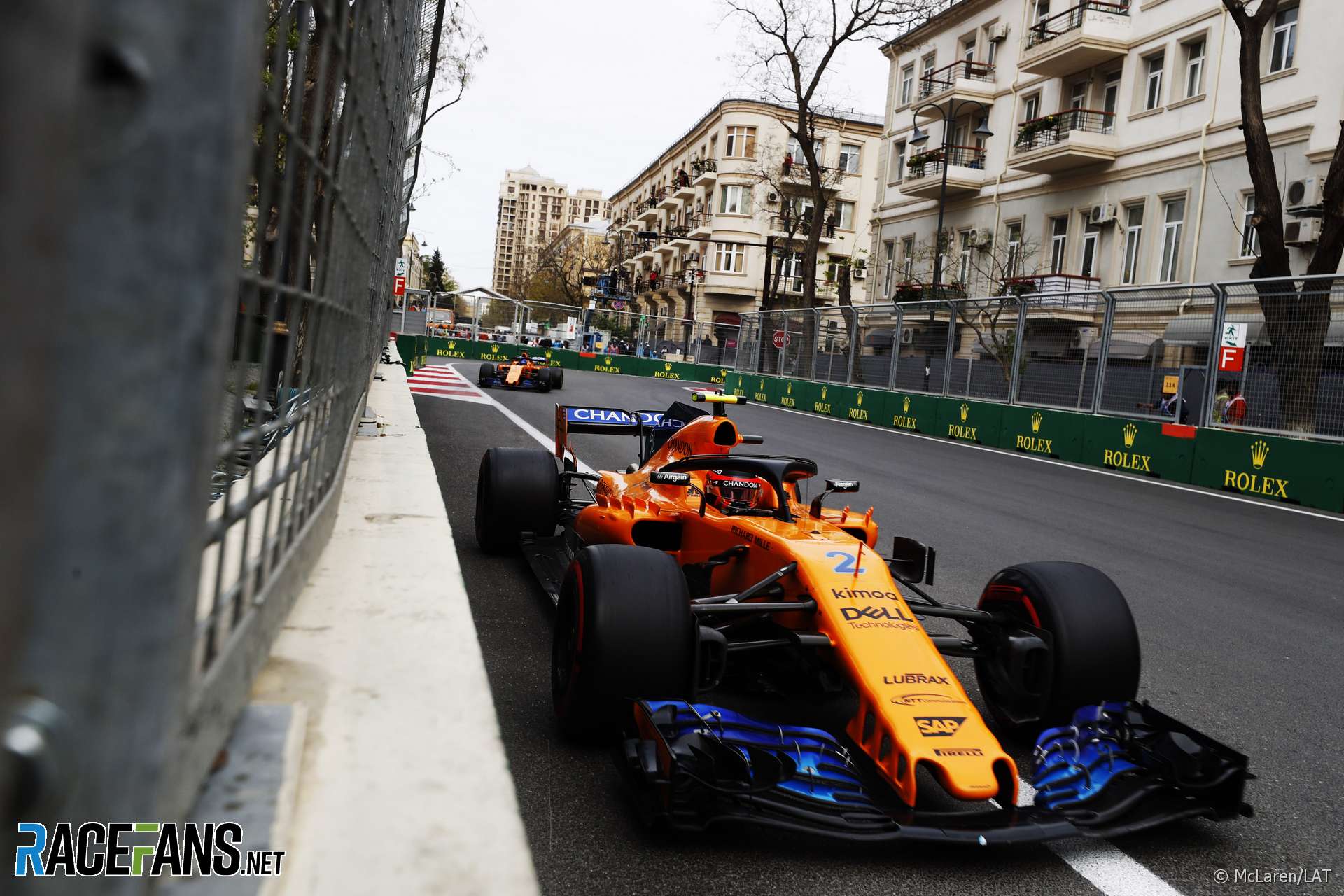Street tracks can offer a greater challenge to Formula 1 drivers because they don’t need the kind of compromises found on on permanent tracks, according to racing circuit designer Hermann Tilke.
Asphalt run-off and low kerbs have been criticised for making permanent circuits too forgiving for F1 drivers. However Tilke points out these changes have usually been made for other reasons.
“The tracks must be safe,” he said at the FIA Sport Conference in Manila. “We are not building tracks only for the high-level professional drivers, we’re also building tracks for any kind of drivers, which means amateur drivers, and other drivers that might just want to drive a high performance car.“With autonomous driving, more people are going to come to tracks to have fun with cars. All of these people have to be safe – not only Formula One. The investor of a track wants to use his track for everybody – not only for Formula One.”
Liberty Media is pursuing new races on street circuits, such as the proposed track in Miami. Tilke says the advantage of temporary circuits such as this is they don’t have to be designed with the average driver in mind.
“We have real street races, we have three in the calendar at the moment – Monaco, Singapore and Baku – and all these three are so different and so unique this makes it really very interesting. For the high professional [championships] like Formula 1, it is the right way.”

However he pointed out permanent circuits have also delivered exciting races this year.
Three of the first five F1 races this year were “really very thrilling”, he said. “One was Baku and the other ones were permanent tracks with a lot of run-offs and all those things. But it was also very thrilling races. This means it must not necessarily be street or city tracks.
“But of course the trend is going to the city tracks and this is really good for professional drivers.”
Advert | Become a RaceFans supporter and
2018 F1 season
- McLaren staff told us we were “totally crazy” to take Honda engines in 2018 – Tost
- ‘It doesn’t matter if we start last’: How Red Bull’s junior team aided Honda’s leap forward
- Honda’s jet division helped F1 engineers solve power unit problem
- McLaren Racing losses rise after Honda split
- Ricciardo: Baku “s***show” was Red Bull’s fault





BasCB (@bascb)
18th June 2018, 11:13
Hm, I get his point. And he might be right about the lack of compromise to make for less skilled drivers, less safe equipment and other motorsports.
But then, street tracks also mean the layout is limited by which streets are available (see also Chinese E-prix with a hairpin that nobody could actually take!) and tend to be less than great for passing because of the space available.
So instead of having to compromise for other users, really F1 has to compromise because it is dealing with all of that which is already there.
JohnH (@johnrkh)
18th June 2018, 11:46
It’s easy enough to remove the changes made in the name of “safety” from a permanent circuit. That would make them far more exciting. When he says “professional” I suppose he means good?
Nah I do not agree with his theory.
lee1
18th June 2018, 15:19
Indeed. If that is the problem then why not merely put temporary barriers closer to the track for F1? You know… like they do for street circuits!
JohnH (@johnrkh)
18th June 2018, 21:37
Haha no you may well end up with the same problem as a modern st circuit, no run off no passing no good for “pro” drivers? A well designed permanent track would be far superior…I think anyway.
And as has already been pointed out more versatile therefore more cost effective if managed correctly.
lee1
20th June 2018, 11:59
I am not proposing moving the barriers to the track limits!
They however could be moved nearer the track than they currently are in order to reduce the runoff areas and therefore punishing mistakes a little more than they currently do.
petebaldwin (@)
18th June 2018, 16:12
I be careful when interpreting the FIA’s use of the word “Pro” as “F1 TV Pro” demonstrates…..
Greg
18th June 2018, 21:16
No, because if they (circuit owner, FIA, Liberty) remove some safety features, and someone dies in an accident, relatives of the driver will sue them faster than you can imagine.
JohnH (@johnrkh)
18th June 2018, 21:48
Well considering that many accidents are caused by driver error I do not see the small additional risk of removing some of these so called “safety” improvements being a significant factor. I’m pretty sure that most of the drivers if asked would prefer more challenging circuits.
Lets not forget that in primary and secondary safety the cars are far superior to cars from just 20 yrs ago.
Matthijs (@matthijs)
18th June 2018, 12:05
I was expecting some Tilke-bashing but he does have a point. Circuits aren’t built solely (or even primarily) for F1. I have been told that the extensive runoffs and smoothening of many F1-track are for motorbikes (MotoGP, Superbikes).
JohnH (@johnrkh)
18th June 2018, 13:00
Not totally correct, the argument was made some time ago by F1 drivers that they could better control/stop their cars if they over shot a corner on a hard surface = Asphalt rather than a gravel trap. Also the mechanics did not like the idea of stones damaging the radiators or potentially getting into the engines through the air intakes.
Oh and by the way, disagreeing with someone is not bashing.
Matthijs (@matthijs)
18th June 2018, 13:23
Well, cannot argue about that. But I’m talking about the length of the run-off, for instance Catalunya.
http://www.circuitcat.com/en/news/circuit/the-circuit-will-broaden-the-run-off-area-at-the-former-turn-12-and-re-asphalt-the-track-for-2018/
Matthijs (@matthijs)
18th June 2018, 13:27
Well Catalunya might not be the best example here, but I just wanted to stress that the circuits indeed must meet the safety requirements of both cars and bikes as well as hobby-drivers.
https://motomatters.com/news/2014/10/10/motogp_safety_commission_push_to_remove_.html
ruliemaulana (@ruliemaulana)
18th June 2018, 12:13
Very sensible, but let me rephrase the first paragraph:
“Permanent tracks design should offer a greater challenge to Formula 1 drivers because they don’t need the kind of compromises found on typical tracks.” Tilke.
johnny Five
18th June 2018, 13:02
So the “permanent” tracks need 50 metres of runoff to make it safe for track-day amateurs and motorbikes: here’s my tuppence-worth. On the one weekend a year when F1 visits, make a hay-bale fence 25 metres from the track edge to put half of the excessive run-off out of bounds. It won’t kill anybody if they hit it, but it would be a great incentive for drivers not to go off-piste for fear or damaging a wing, or something.
Jeffrey (@jeffreyj)
18th June 2018, 15:11
So, then why not go racing at a classic track like Zandvoort, mister Tilke? It has zero runoffs! Somehow it’s currently only used for trackday driving and for all levels and series of car-racing EXCEPT Formula 1?!! If what you are saying is true, let’s get a GP on there ASAP then!!
Nah, this is about something else entirely. This is clearly a blatant attempt to push Liberty Media’s real agenda: giving governments better reasons to keep paying them big money
Race promoters are rapidly losing the support of public funding and are thus having trouble to pay F1’s exorbitant fee’s (see Malaysia and also Austin). Governments just aren’t as willing to fund F1 races anymore because they can’t justify the economic gains.
Now, a street race in the middle of a city that shows the world all the attractions as the cars race by (think off the Baku castle or the Singapore skyline), and spectators spending their money directly in the city as the event is hapening, now THAT is a reason for a government to keep pouring public funds into a F1 race. Liberty is simply trying to protect one of F1’s most important income streams: government funding.
petebaldwin (@)
18th June 2018, 16:17
I think you’re right. Circuits are expensive to run so rather than cutting hosting fees, they’ll move the events to cities and continue to charge huge amounts.
Liberty don’t want the people who run classic circuits showing up with (as Bernie described it) begging bowls. They want rich governments to put on GPs to increase tourism.
Jimmi Cynic (@jimmi-cynic)
18th June 2018, 20:11
@jeffreyj: Well said.
Liberty must keep pouring millions into Bernie’s $8 Billion begging bowl.
JohnH (@johnrkh)
18th June 2018, 22:01
Melbourne only just got renewed by the skin of its teeth four years ago, as the numbers did not stack up. The government of the day pulled a swifty to get it through.
There is still quite a bit of resistance to Melbournes street race.
Garns (@)
19th June 2018, 13:50
@johnrkh
Its been like that for some time John, big money, constant protestors (that need a job) but the city doesn’t seem to embrace F1 and are over it. I have been in a taxi going to the track and the driver is vaguely aware a world class sporting event is on.
Adelaide embraced F1 much more and the whole place turned into Party Town (or Party Mode as per HAW :) – its was what like people describe Montreal now. If Liberty are looking at street tracks in city centres they should revisit Adelaide. The track would certainly need extending, which is possible, and I think still holds greatest race attendance in 1995 of something like 205,000 on race day.
Rhys Lloyd (@justrhysism)
20th June 2018, 13:35
As a I live near and work in Adelaide I would be up for that.
Can’t see it happening though – local government doesn’t have the cash; and we already have a big annual race which takes over the city (Adelaide 500) during what we call “Mad March” as there are effectively at least 3 large concurrent events, not least the Fringe Festival which is right next to the circuit (new circuit, old circuit cuts through the festival).
But there are many here still pining for F1, so much so that they’re trying to create a “Goodwood Festival of Speed”-style event: the “Adelaide Motorsport Festival” which has seen several classic F1 cars return to the streets of Adelaide. It’s wonderful!
ADUB SMALLBLOCK (@waptraveler)
18th June 2018, 15:20
“With autonomous driving, more people are going to come to tracks to have fun with cars.” Really? “I think I’ll take the Tesla to the track today and let it drive me around”. Is that what he means???
Martin
18th June 2018, 16:53
*sigh* No.
He means that, in a world where all commuting is autonomous, track days will be one of the few chances people will get to drive for themselves.
Rhys Lloyd (@justrhysism)
20th June 2018, 13:36
Bingo.
Matthijs (@matthijs)
18th June 2018, 18:51
@waptraveler I think he means: when you don’t drive your car for daily commute, you want to have a time to enjoy driving your car yourself.
Robert McKay
18th June 2018, 20:16
Why doesn’t he just say “all the tracks I design are brilliant”.
ajpennypacker (@ajpennypacker)
18th June 2018, 20:47
@bascb I disagree with your last point, because there is plenty that FOM, Liberty, and Tilke can do before approving a layout. Yes, there are limitaitons because it’s on the street. But the whole point of what Tilke is saying is that they get to choose. I’d say that Baku and Singapore are pretty good tracks. Yes… Baku’s straight should be shorter, and Singapore can be a hassle to overtake. But I think they have all provided pretty exciting races from the beginning. I really hope they get Miami done. With a different layout than what was presented, but I hope they do it.
BasCB (@bascb)
19th June 2018, 8:02
Sure, you can make a decent city circuit @ajpennypacker. But it still is a clear compromise – At singapore it was dictated by the roads available, the sights the council insisted on including, space to actually put in grandstands. Both got exciting only because of crashes, without those, the race is just not very good at all.
Garns (@)
19th June 2018, 12:42
Did he forget Melbourne is a street circuit?
This guy is usually like Helmut Marko- when he talks I don’t tend to listen. But I think he makes a good point where permanent tracks need to consider other users other than F1. He also seems to make a dig at a few drivers on the grid that some are F1 drivers, and other Pro F1 drivers, meaning if you can drive Monaco or Baku well you have more skill than some of the others- I can see his point there.